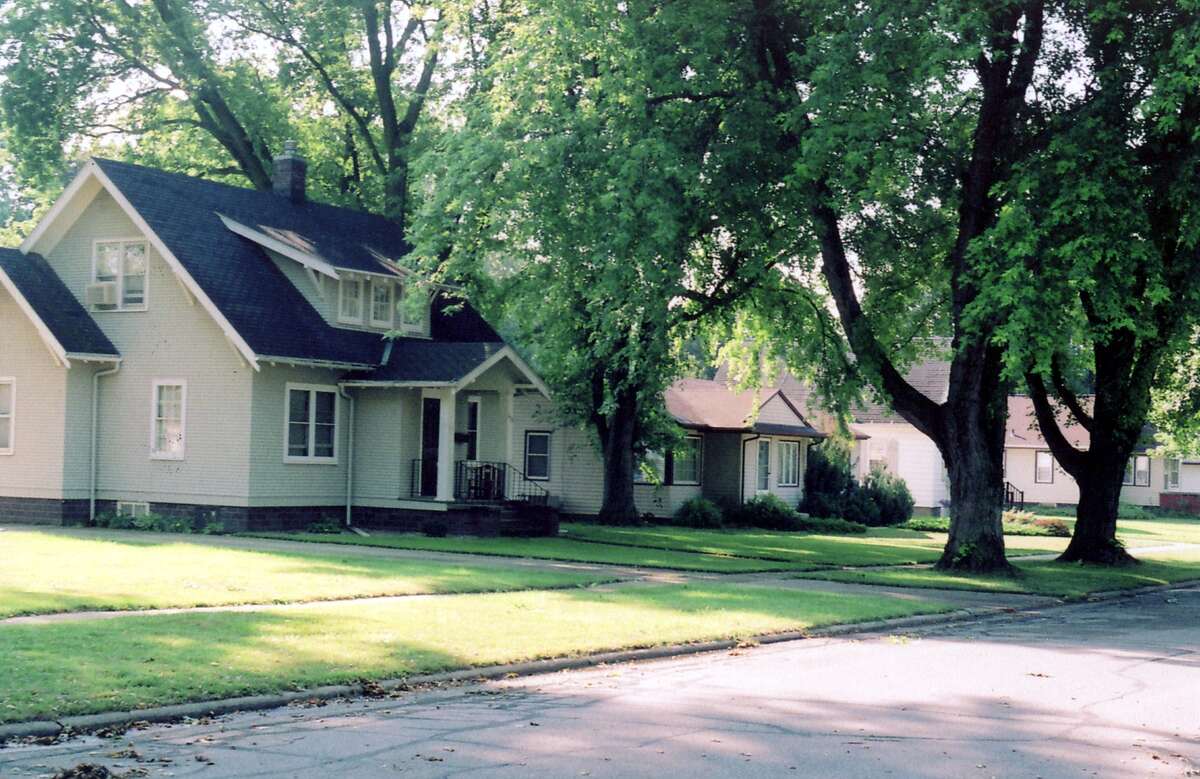
You’ve probably heard the term “aeration” thrown around, but maybe you’re unsure what it is or if your Iowa lawn needs it. Aeration is a process that relieves soil compaction, so air, water, and nutrients move freely into the ground, improving root growth and turf health. Discover everything you need to know about lawn aeration in Iowa, from DIY to professional services, and more.
What is Aeration?
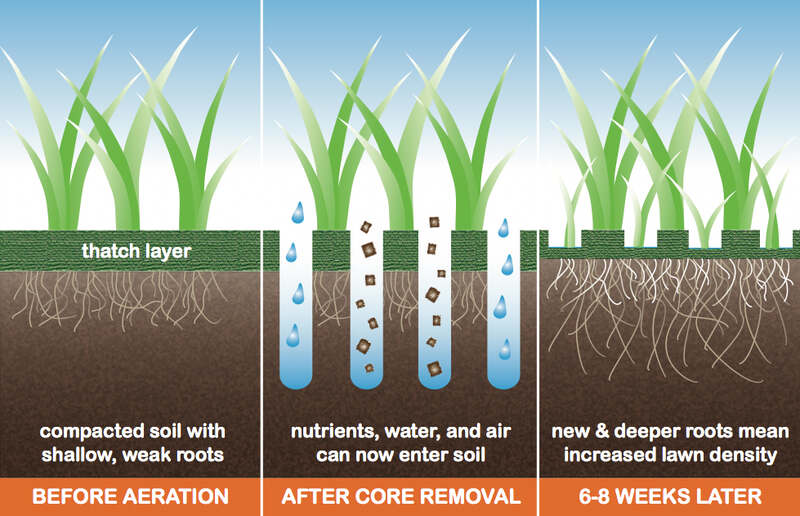
There are two different methods to aerate, core and spike, and they both reduce soil compaction.
Core aeration relies on heavy equipment using hollow tines to dig into the ground and pull soil plugs out to create space for root growth, air, nutrients, and water. It is suitable for all yard sizes.
On the other hand, spike aeration typically uses manual equipment with pointed tines to punch holes into the soil. This method is best suited to smaller yards.
Everything You Need To Know About Core Aeration
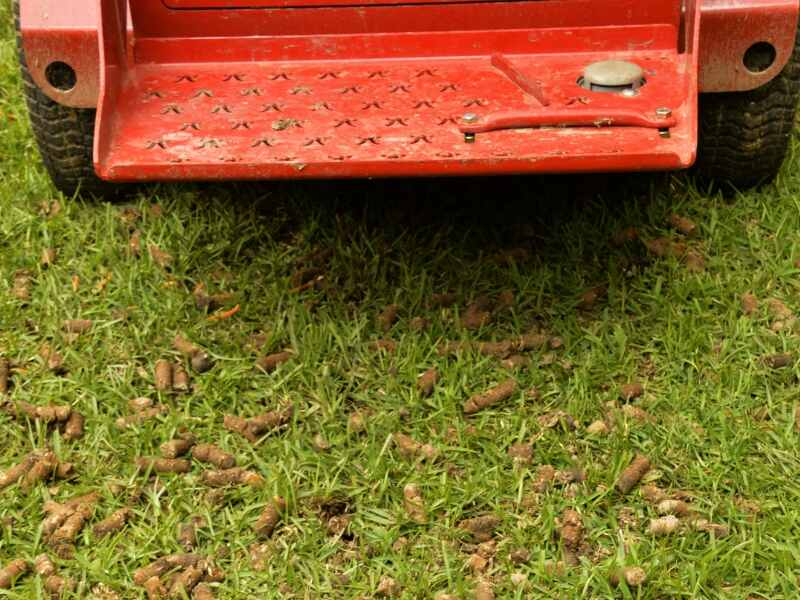
Core aeration removes small soil plugs or cores using hollow, cylindrical tines measuring around three inches long and one inch in diameter. When these cores are pulled from the ground, they create holes in the soil, reducing soil compaction.
Core aeration is exceptionally effective and the industry standard for lawn professionals. When done correctly, it loosens soil compaction, giving grassroots better access to nutrients, air, and water. You’ll see improved soil health and a healthy lawn.
When Should You Core Aerate?
The best time to core aerate depends on your grass type, but you should aim to aerate when your turfgrass is actively growing.
For cool-season grasses, aerate in the late spring or early fall; for warm-season turfs, aerate during the early to mid-summer when growth is vigorous.
To determine when you should core aerate, it’s important to figure out if you have cool-season or warm-season grasses.
Homeowners in Northern Iowa typically grow cool-season grasses like Kentucky bluegrass, perennial ryegrass, tall fescue, or fine fescues. However, homeowners in Southern Iowa lie in the Transition Zone and can grow cool-season or warm-season grasses like Bermudagrass, Zoysiagrass, or buffalograss.
Pro tip: For more information on timing aeration with other lawn care practices, check out our Iowa lawn care schedule.
How Often Should You Core Aerate?
Expert recommendations on aeration frequency change, depending on several factors:
- Aerate silt or loam lawns with high foot traffic annually.
- Aerate sandy soil or lawn with little foot traffic every two to three years.
- Aerate clay soil twice per year.
Pro tip: Iowa’s soils are rich and fertile and the envy of farmers everywhere. About two-thirds of Iowa’s soils are silt or loam, and the remaining one-third are more dense, with higher clay contents.
Types of Core Aerators
There are various types of core aerators. Gas-powered core aerators are popular for larger lawns, while manual aerators are a budget-friendly alternative.
- Gas-powered plug aerators are beefy machines that look like a rototiller on steroids. You walk behind these unwieldy things, maneuvering them back and forth across your grass.
- Tow-behind plug aerators attach to the hitch of your garden tractor or ATV. As you drive across your grass, they rotate and pull soil plugs.
- Manual hollow tine aerators are handheld. You use your foot–like a shovel–to push the hollow tines into the soil. When you pull them out, they pull out cores.
Everything You Need To Know About Spike Aeration
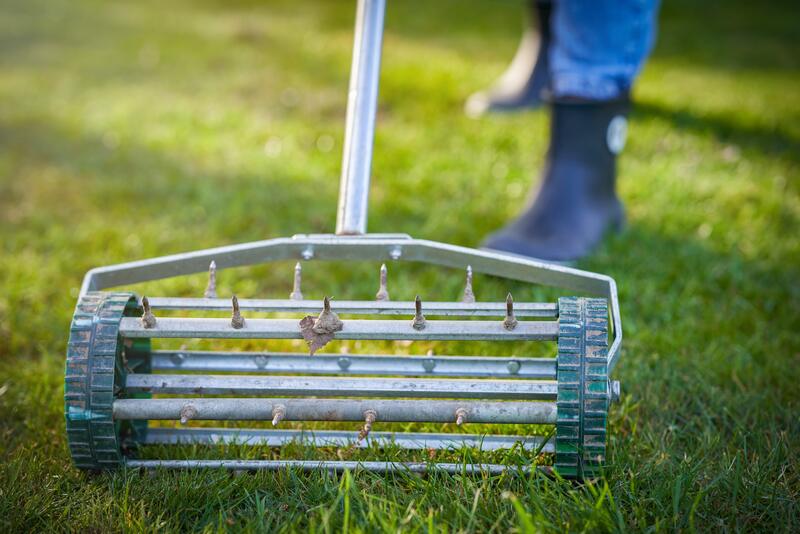
Spike aeration does what its name implies: it drives long metal or plastic spikes into the soil, creating holes. These small holes open the ground, allowing water, air, and nutrients to move into the soil.
Spike aeration is a great option for breaking up minimal soil compaction or for preparing your lawn for fertilizing or overseeding to improve soil contact. However, it is less effective than core aeration on severely compacted lawns, and this method can increase compaction if done too often.
When Should You Spike Aerate?
Like core aeration, it is best to spike your lawn when your grass is actively growing, although you can do it anytime the ground isn’t frozen.
If you only do it once during the growing season, spike aerate warm-season turfs in the late spring and cool-season grasses in the early spring or fall.
As mentioned above, homeowners in northern Iowa typically grow cool-season grasses, but those in southern Iowa may grow war-season turfs too. Some maps classify the lower part of the state as the transition zone.
How Often Should You Spike Aerate?
If you are only spiking your lawn and not core aerating, you can do it two to three times throughout the growing season. However, if you’ve had core aeration done within the last two years, you shouldn’t spike aerate more than once during the growing season.
Types of Spike Aerators
Spike aerators are a great option for smaller yards. They are less expensive than core aerators, though they require some elbow grease to operate.
- Spike shoes have narrow, sharp spikes resembling long nails protruding from the soles. You put them on your feet, and they poke holes in your lawn as you walk.
- Manual spike aerators are handheld gadgets about the size of a shovel. You place the tines on your grass and push down on the flat bar to drive the points into the soil.
- Rolling spike aerators look like spiked lawn rollers. You push it across your lawn, and the tines poke into the soil, creating holes.
Can You DIY Aerate Your Lawn?
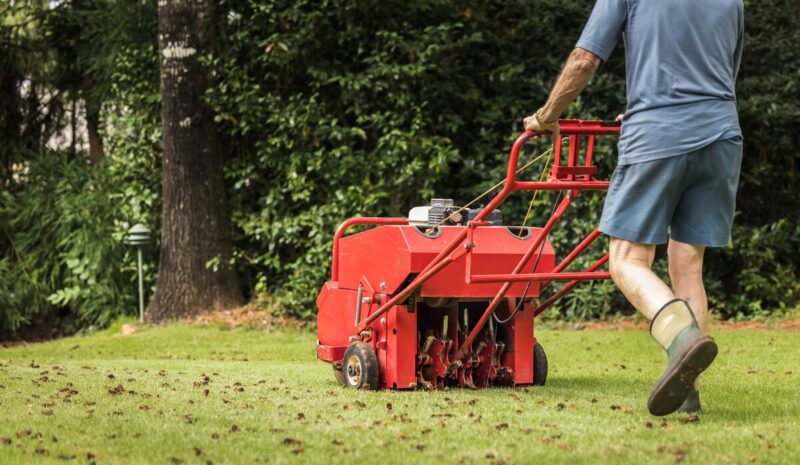
Aeration is pretty straightforward and something you can certainly take on as a DIY project. The cost involved depends on the type of aeration you’re doing and if you choose to rent or purchase equipment.
Many homeowners rent gas-powered core aerating equipment from The Home Depot or Lowe’s for about $70 for four hours or $100 per day. You can also purchase equipment, but be warned an entry-level walk-behind core aerator costs about $1,500, and prices quickly increase from there.
Tow-behind plug aerators are a little cheaper because they don’t have an engine. You can expect to pay about $300 for a non-weighted unit, but you’ll need to factor in the cost of sandbags or other heavy items to set on top of it to keep it in contact with the ground. Spike aerators are much cheaper to purchase and cost as little as $50.
Here are some basic steps to help you get the most out of this lawn care practice:
- Check for compaction by pushing a flat-head screwdriver into the soil. If it’s hard to jab into the ground, you have compacted soil you need to address.
- Water your lawn one to two days before you plan to aerate. Moist soil makes pulling cores easier.
- Mow your grass shorter than usual, setting the deck to 1.5 to 2 inches.
- Flag hidden objects in your grass, including sprinkler heads, large tree roots, and shallow utilities.
- Start at the perimeter of your lawn, making straight passes across your grass. If you are using a core aerator, always lift or disengage the machine before turning it for your next pass.
How Much Does Professional Lawn Aeration Cost?
The cost of professional lawn aeration services varies depending on your lawn’s size, aeration type, and locale. Professional lawn aeration services typically cost between $75 to $225, with the average homeowner paying about $145 for the service.
What Causes Soil Compaction?
There are a few situations that increase soil compaction, including:
- Heavy foot traffic: Foot traffic is the number one cause of soil compaction.
- Dense soil: Soils with high amounts of clay are more prone to compaction than sand or loam.
- Low organic matter: Organic matter improves soil structure. Low organic matter leaves soil susceptible to compression.
- Poor drainage: Excessive irrigation and poor drainage cause waterlogging which can lead to soil compaction.
FAQ About Lawn Aeration in Iowa
Should I remove the plugs after core aerating?
No. Leave the soil plugs on your lawn to disintegrate. The plugs release microbes that break down your thatch layer, aiding in nutrient absorption and soil composition.
Are aerating and dethatching the same thing?
No, aerating and dethatching are different processes. Aeration relieves soil compaction. Dethatching removes the thatch layer from the top of the soil to improve air, nutrients, and water movement into the ground.
Can I mow after aerating?
If you spike aerate your lawn, you can mow immediately. If you core aerate, give your grass at least two weeks to grow before you cut it.
Not Ready to Aerate Yourself?
Aerating is a critical component of lawn maintenance that decreases soil compaction and improves your grass’ health. However, tackling lawn aeration may be a bigger job than you’re looking to take on.
We get that, and we are here to help. If you’re looking for a high-quality lawn care service to help with your yard work, let LawnStarter put you in touch with an Iowa lawn care team.
Main Photo Credit: Don Graham / Flickr / CC BY-SA 2.0
Editorial Contributors
-

Amanda Shiffler
Author
Most comfortable with soil under her fingernails, Amanda has an enthusiasm for gardening, agriculture, and all things plant-related. With a master's degree in agriculture and more than a decade of experience gardening and tending to her lawn, she combines her plant knowledge and knack for writing to share what she knows and loves.
Learn more -

Kimberly Magerl
Editor
Kimberly Magerl is a writer and editor specializing in landscaping, gardening, lawn care, and pest control. She enjoys growing orchids, tending to fruits and vegetables in her garden, and cooking with her home-grown herbs.
Learn more